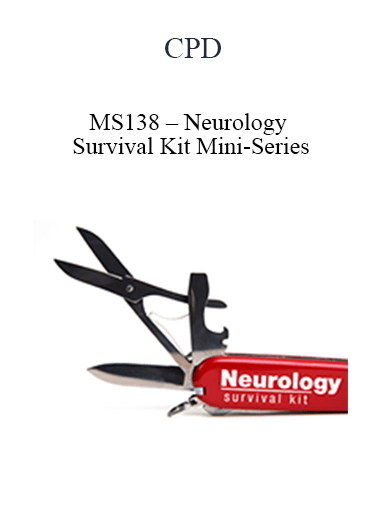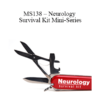$479.00 Original price was: $479.00.$114.00Current price is: $114.00.
 Purchase this course you will earn 114 Points worth of $11.40
Purchase this course you will earn 114 Points worth of $11.40Elevate your skills with the CPD – MS138 – Neurology Survival Kit Mini-Series course, available for just $479.00 Original price was: $479.00.$114.00Current price is: $114.00. on Utralist.com! Browse our curated selection of over 60,000 downloadable digital courses across diverse Everything Else. Benefit from expert-led, self-paced instruction and save over 80%. Start learning smarter today!
Purchase CPD – MS138 – Neurology Survival Kit Mini-Series courses at here with PRICE $479 $114

MS138 – Neurology Survival Kit Mini-Series
£347.00 (+VAT)
12 months access to recordings and course materials is included. Please note that these are webinar recordings and not live events. Full details on how to access the Mini Series will be emailed to you.
- Join Laurent Garosi DVM, MRCVS, Dip ECVN – RCVS & European specialist in Veterinary Neurology for three 2-hour online sessions
- Comprehensive notes to downloaded
- Self-assessment quizzes to ‘release’ your 8 hours CPD certification (don’t worry, you can take them more than once if you don’t quite hit the mark first time)
- A whole year’s access to recorded sessions for reviewing key points
- Superb value for money – learn without travelling
- Watch the recordings on your iPad!
Programme
Spinal or neuromuscular problem?
Spinal diseases are important causes of disability in dogs. One of the main difficulty remains in many cases for the clinician to recognise the origin of the disorder as being the spinal cord and to eliminate other origin of abnormal gait such as cerebral or neuromuscular disorder. Investigations of weak or paralysed patient require a very accurate clinical neurolocalisation before considering any further diagnostic tests. This session is designed to provide you with a simple step-by-step approach to examining a weak or paralysed patient and the tool to formulate a logical differential diagnostic list.
What you’ll learn:
- Understand principles of lesion localisation in patient presented with paresis/plegia with the help of lots of practical videos
- Know how to recognize clinically a neuromuscular disorder
- Being able to distinguish spinal cord from neuromuscular neuro-anatomical diagnosis
- Being able to establish a differential diagnosis list in relation to spinal cord or neuromuscular presentation
- Understand basis of grading system in spinal patient
- Establish a logical step-wise diagnostic approach to a neuromuscular disorder
Ataxia, tight jaw, dropped jaw and droopy faces
Ataxia is defined as incoordination, wobbliness or unsteadiness due to a failure to regulate truncal posture, and the strength and direction of limb movement. As we are going to see in this session, the origin of ataxia can be subdivided into three forms on the basis of the neuroanatomical diagnosis: cerebellar, vestibular and general proprioceptive (also known as sensory) ataxia. A good understanding of how these sensory systems work is fundamental to establish a clinical diagnosis of the different types of ataxia. The type of ataxia identified on neurological examination will select the differential diagnoses and determine the diagnostic tests to be performed. Tight jaw, dropped jaw and droopy faces are frequent manifestation of cranial nerve neuropathy. Though, non-neurological causes should be ruled-out first before embarking of expensive neurological test. This session will discuss common neurological causes, their diagnostic and management.
What you’ll learn:
- Video tour to differentiate clinically between the different types of ataxia
- Provide a step-wise approach to working up an ataxic dog or cat
- Differentiate peripheral from central vestibular disease
- Recognising bilateral vestibular disease
- Being familiar with the common neurological and non-neurological causes of tight jaw, dropped jaw and droopy faces
Everything you always wanted to know about seizures and paroxysmal dyskinesia
Epileptic seizures are one of the most common neurological presentations in practice. There are considerable overlaps between epileptic seizures and other type of collapse such as paroxysmal dyskinesia. This session will provide you with a step-wise logical approach to epileptic seizures and other neurological mimics including what should be the minimum neurological examination to perform in such cases, how to choose appropriate diagnostic tests, when to refer and when/how to treat. This session will cover management of refractory and emergency.
What you’ll learn:
- Video tour of different types of seizures encountered in dogs
- When should you suspect idiopathic epilepsy or an underlying metabolic or brain disease?
- How to recognise paroxysmal dyskinesia from video footage and how to manage it?
- What anti-epileptic drugs are available for treating seizures in dogs and cats? When would you choose one over the other and what are the advantages and disadvantages of each? What sort of success do we expect when treating seizures?
- How do you manage refractory cases?
Purchase CPD – MS138 – Neurology Survival Kit Mini-Series courses at here with PRICE $479 $114
Cultivate continuous growth with the CPD – MS138 – Neurology Survival Kit Mini-Series course at Utralist.com! Unlock lifetime access to premium digital content, meticulously designed for both career advancement and personal enrichment.
- Lifetime Access: Enjoy limitless access to your purchased courses.
- Exceptional Value: Benefit from savings up to 80% on high-quality courses.
- Secure Transactions: Your payments are always safe and protected.
- Practical Application: Gain real-world skills applicable to your goals.
- Instant Accessibility: Begin your learning journey immediately after buying.
- Device Compatible: Access your courses seamlessly on any device.
Transform your potential with Utralist.com!
Related products
Everything Else
= 47 Points
= 89 Points
Everything Else
= 38 Points
Everything Else
= 43 Points
Everything Else
= 89 Points
Everything Else
= 43 Points
Everything Else
= 137 Points
Everything Else
= 37 Points












